Milano Design Week 2022 WOVEN NARRATIVES – Kyoto, the landscape of Four Symbols –
Exhibition to be held at Circolo Filologico Milanese,
the oldest cultural association in Milan.
Art Direction by creative unit AtMa inc.
Exhibition Dates: June 7 – 12th, 2022
Kawashima Selkon Textiles (Headquarters: Sakyo-ku, Kyoto; President: Koichi Kimura) will be exhibiting at Milan Design Week, the world’s largest design festival, from June 7th (Tuesday) to June 12th (Sunday), 2022. The exhibition “WOVEN NARRATIVES – Kyoto, the landscape of Four Symbols” will be held at the library of Circolo Filologico Milanese, Milan’s oldest cultural association.
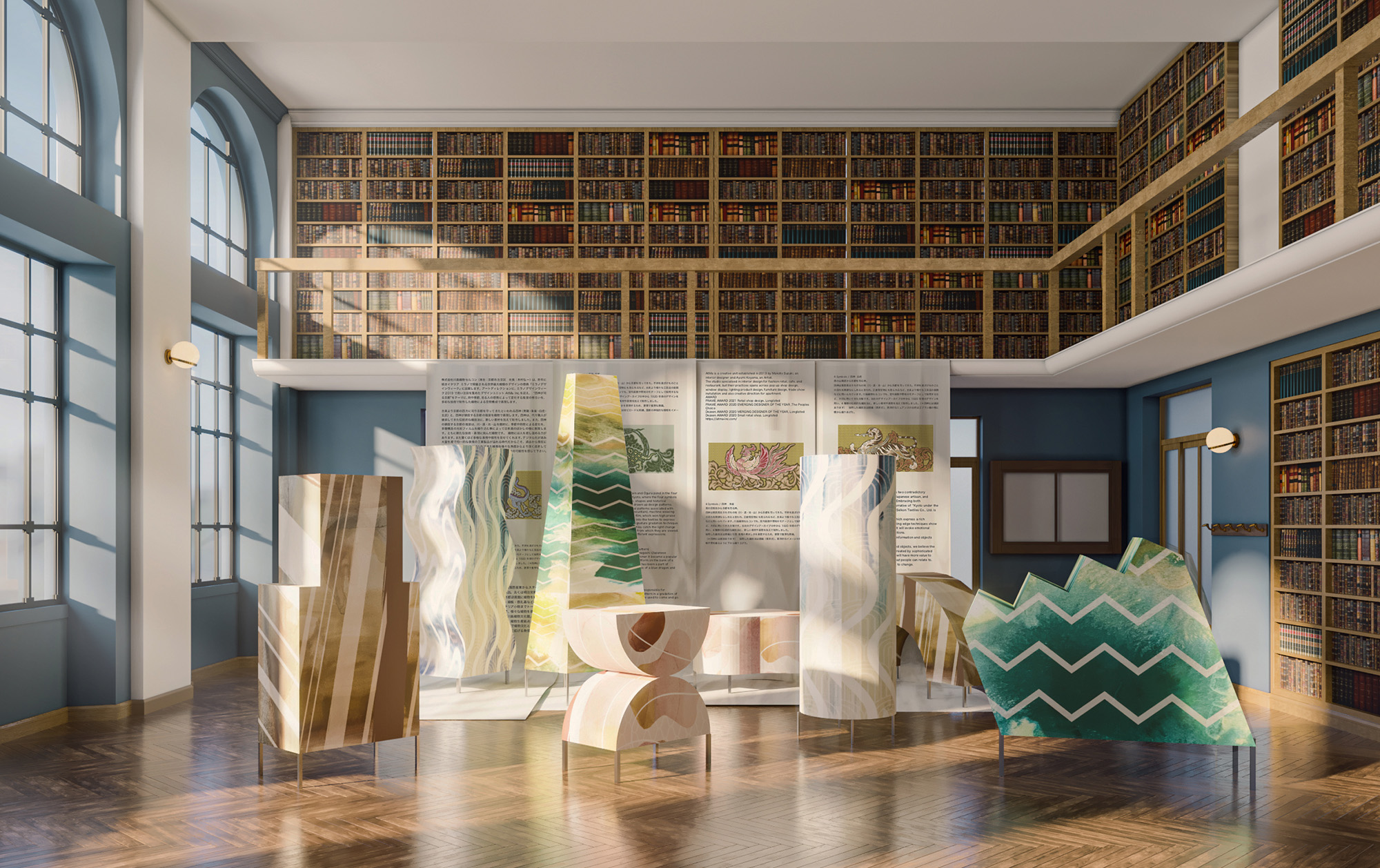
The installation, themed “Kyoto, the landscape of Four Symbols,” and art-directed by the internationally acclaimed creative unit AtMa inc., will be Kawashima Selkon Textiles’ second exhibit at Milan Design Week following 2019. The story of the “Four Symbols” (Seiryu, Byakko, Suzaku, and Genbu), the divine guardians of Kyoto since ancient times, and the “scenery of Kyoto”, a landscape with a 1000-year legacy, are expressed through the eight fabrics newly released for this exhibition and its dynamic spacial arrangement.
The fabrics in this installation are rich in expression and have been created by blending Kawashima Selkon Textiles’ traditional techniques and knowledge, cultivated throughout the company’s long history, with modern techniques and materials. Together, the fabrics create a setting that tells the story of Kyoto woven throughout the ages while also hinting at the possibilities of textile innovation.
Installation “WOVEN NARRATIVES – Kyoto, the landscape of Four Symbols -”
Kyoto, the birthplace of Kawashima Selkon Textiles, presents an ever-changing landscape with a 1000-year legacy. It is also home to the Four Symbols (Seiryu: the blue dragon in the east, Byakko: the white tiger in the west, Suzaku: the vermilion bird in the south, and Genbu: the black tortoise in the north), the divine guardians that are said to have guarded over the city’s regions (river, road, pond, and mountain) since ancient times. Eight newly released textile works will be displayed as objects and tapestries in a library, a space filled with stories, and the narrative of Kyoto, in which the “Four Symbols” reside, as well as its ever-changing landscape, are depicted through this diverse and emotive installation.
New Fabrics
In addition to four traditionally hand-woven fabrics, the exhibition features the release of four machine-woven fabrics designed by AtMa Inc. The new fabrics, born from the fusion of modern technology with the traditional techniques cultivated by Kawashima Selkon Textiles, vary in expression depending on the angle of lighting and weave a new story into these modern times.
“Four Symbols”
The “Four Symbols” are the divine guardians that are said to reside over Kyoto’s lands from each of its four cardinal directions. The mythological creatures are said to ward off bad luck and make things flow smoothly and have been employed as inspiration for various decorations, including the treasures of Shosoin Temple. Kawashima Selkon Textiles has also inherited the patterns with care and has used them as a motif for interior decorations and obi fabrics. The “Four Symbols” are revived from the company’s design archives circa 1930 and brought to life through the hand-woven fabrics. The fabrics are woven with care by traditional artisans, combining four Nishijin-ori weaving techniques with modern materials to express the fabrics’ intricate designs and exquisite depth.
Seiryu | Blue dragon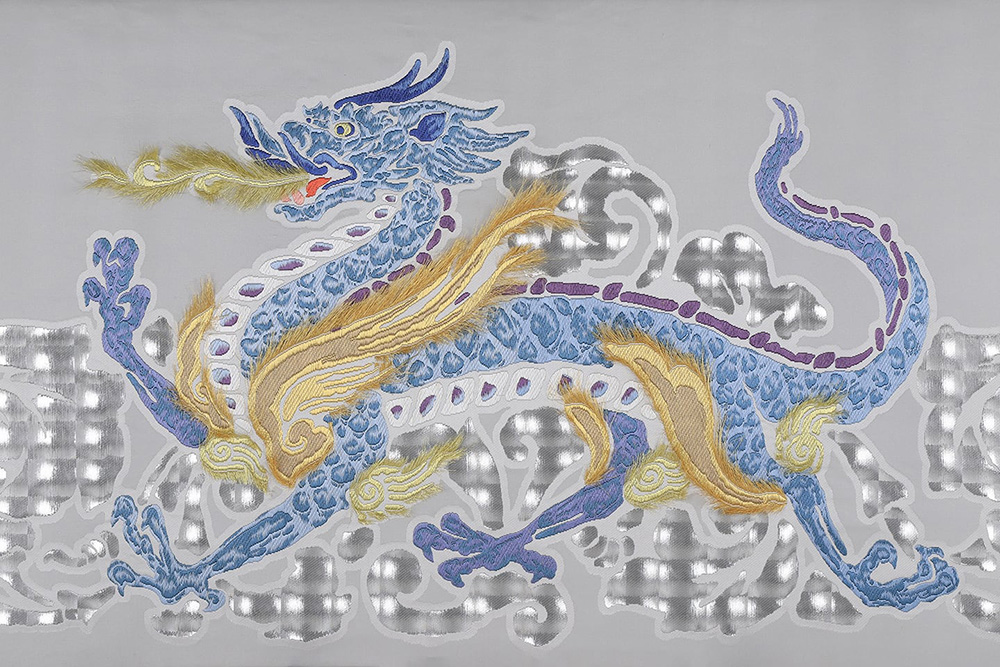 | “Seiryu”, the divine guardian said to reside over the Kamo River that flows through the eastern part of Kyoto. The lens sheet is woven into the fabric using the Karaori and traditional weaving technique known as “Hikihaku,” and expresses the bravery of the blue dragon, with its sharp claws and long tongue. | Karaori Karaori is a technique for weaving patterns and designs on top of a twill weave using gold and silver threads or other vibrantly colored threads, and was originally introduced from China during the Tang Dynasty. It’s renowned for its three-dimensional expressiveness and depth, and is also used to produce costumes and bridal gowns for the traditional Japanese performance art “Noh.” |
Byakko|White tiger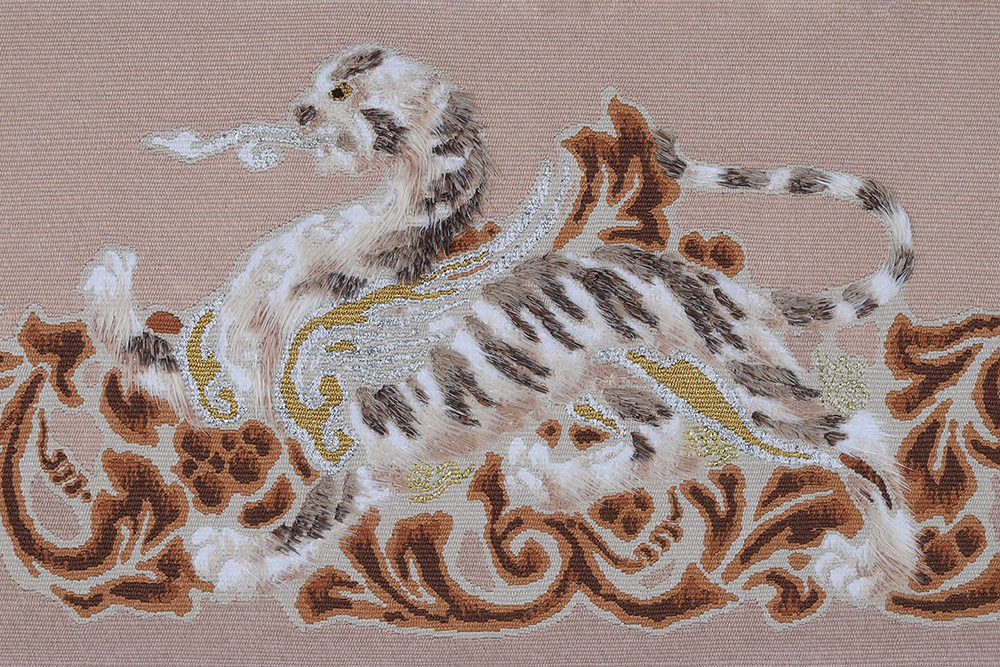 | “Byakko”, the divine guardian said to reside over the Sanyo Road that runs through the Western part of Kyoto. The design is woven in a tsuzure-ori (Western style) from the side of the pattern to express the white tiger’s Western stature and the sacredness of its long limbs. | Tsuzure-ori (Western Style) Tsuzure-ori is the oldest weaving technique for fabrics expressing pictures and designs, and is similar to Gobelins tapestry from France. A sketched design is placed under the warps, and the wefts are woven in accordance as if drawing a picture. |
Suzaku | Vermilion bird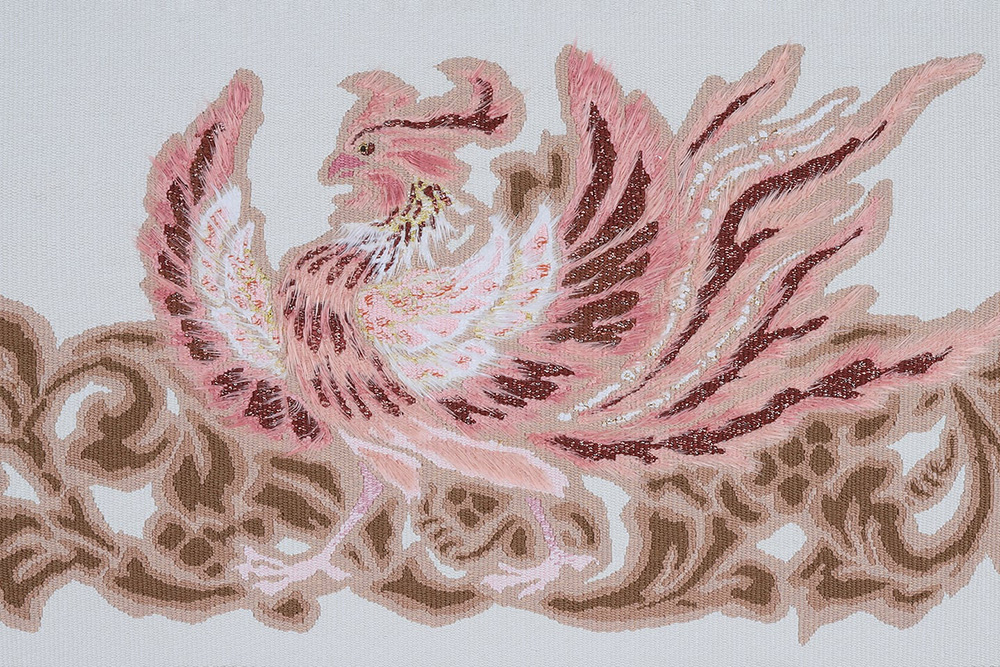 | “Suzaku”, the divine guardian said to reside over the southern part of Kyoto where the Ogura Pond used to lay. The Suzaku, with its phoenix-like wings, is woven horizontally from the bottom of the design using an oriental-style tsuzure-weaving technique typically used for weaving rugs and obis. | Tsuzure-ori (Oriental Style) The oriental style of Tsuzure-ori developed in Japan, while similar in technique to Gobelins tapestry, is ideally suited for delicate picturesque expressions since it is all woven by hand and there is no limit to the number of colours used. The technique, born from the pursuit of greater gradation, is also distinguished by the beauty and precision of the color borders. |
Genbu | Bblack tortoise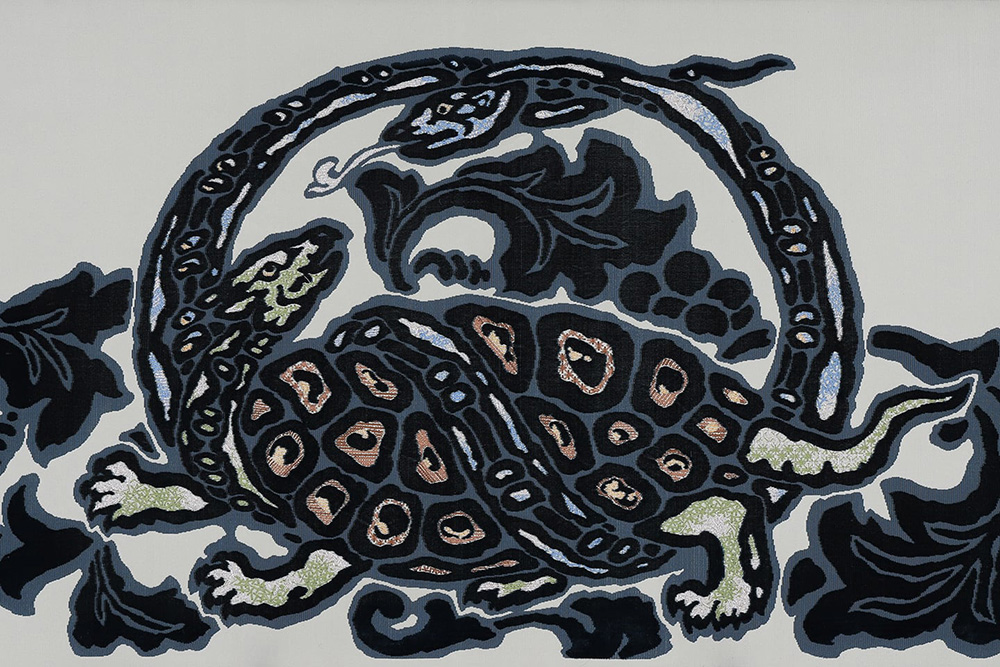 | “Genbu”, the divine guardian said to reside over Mt. Funaoka in the northern part of Kyoto, protecting the city from the north. The sacredness of the Genbu, commonly portrayed as a longlegged tortoise with a snake coiled around it, was expressed in “Mon-Birodo” (patterned velvet), which emanates both dignity and splendor. To make the design more decorative and atmospheric, Japanese embroidery is used. | “Mon-Birodo” (patterned velvet) Mon-birodo is a woven fabric that expresses the different characteristics of Pile (looped yarn) and Cut-pile (cut from looped yarn). The velvet is made by cutting the yarn above the wire that is woven with the weft yarn. The cross section of the yarn is revealed in this cut, giving the fabric a deeper color and a softer velvety feel. |
“Landscapes of Kyoto”
By merging the colors and shapes from Kyoto’s historical background with relevant traditional patterns, the designs express the landscape of Kyoto (rivers, roads, ponds, and mountains), where the four divine guardians are said to reside. The fabric is machine-woven with a distinctive weaving design that resembles “bokashi,” a traditional Japanese painting technique. Its color gradation is made up of a wide range of colored yarns, and multilayered iridescent films are woven into the jacquard weave to evoke different expressions depending on the angle of view and the way the light hits the fabric. Constant experimentation has led to the evolution of these iridescent fabrics into a more expressive form that depicts the ever-changing scenery of Kyoto.
Kamogawa River (East) 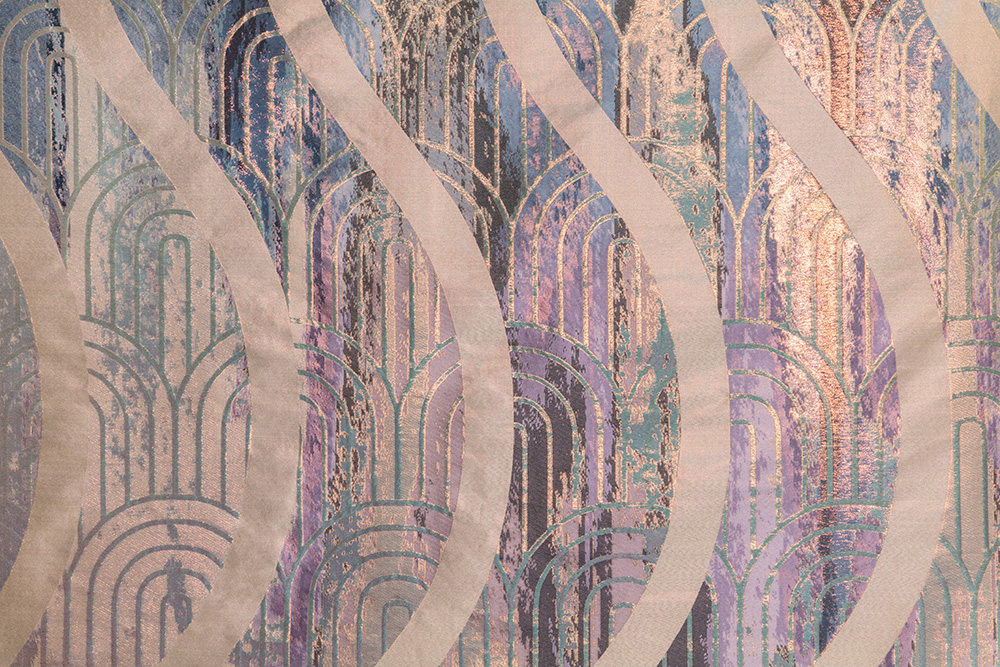 The Kamogawa River, where Yuzen-nagashi (traditional Japanese dyeing) was practiced, has long been treasured as a summertime relaxation spot. The “sea wave” design, with its blue gradation, is inspired by the scales of the blue dragon and the river’s ripples, expressing the scenery of the beloved Kamogawa River. | Sanyo Road (West) 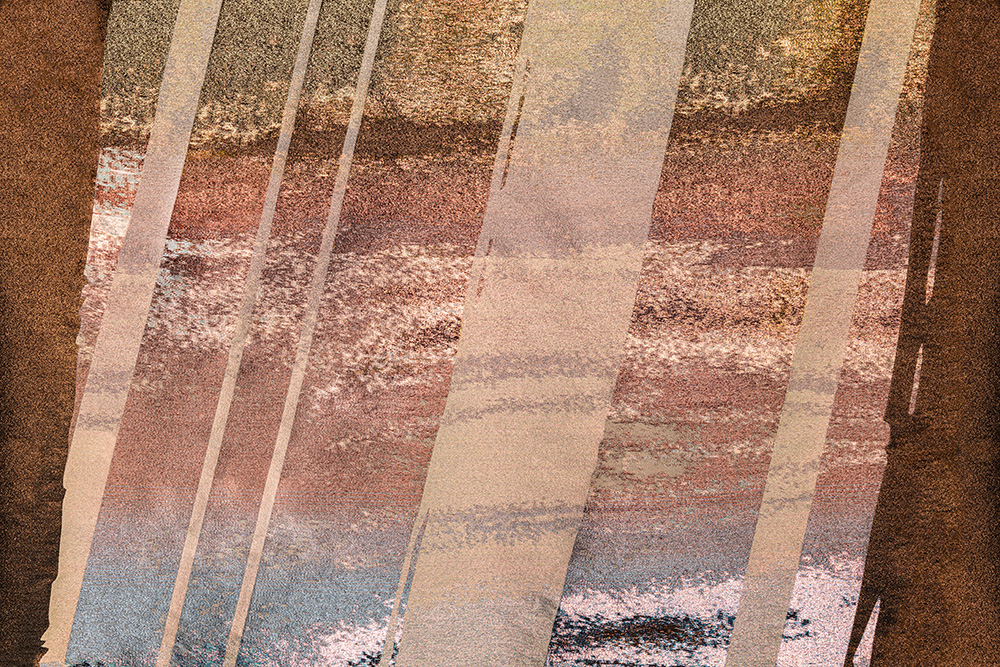 The Sanyo road, which connected Kyoto with Suō province (now Yamaguchi prefecture), has long been relied upon to transport goods and information. The brown gradation of the strata depicts the history of the ancient road, and it is woven with a “Shima” pattern, a striped design that resembles its paths. |
Ogura Pond (South) 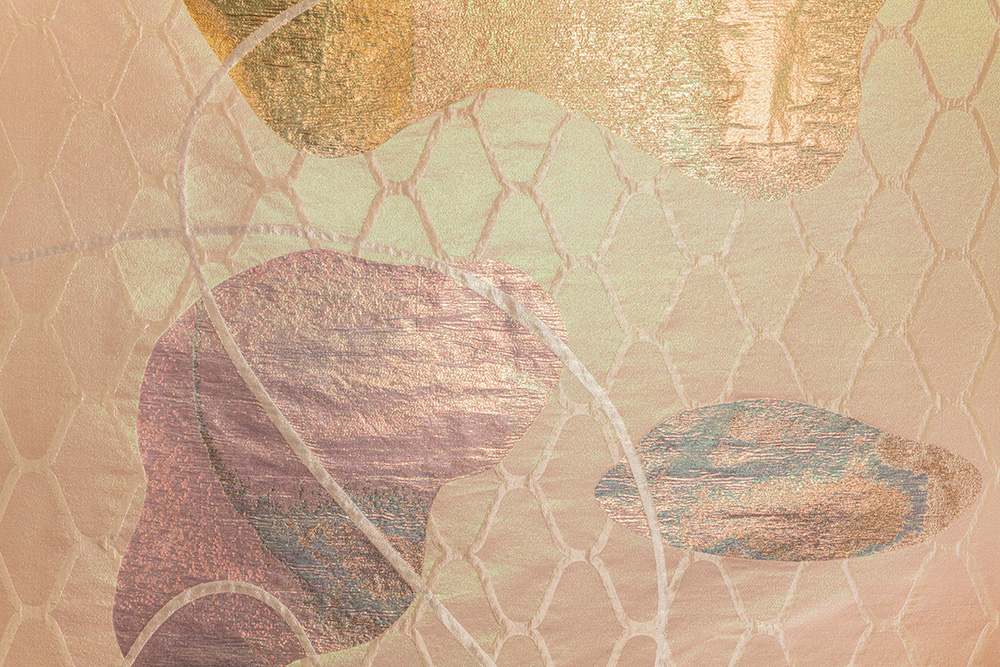 The Ogura Pond, where lotus viewing was famously held. The “amime” (net-like pattern) depicts the booming fishing industry of that time, and the lotus flowers that adorned the pond is represented in pink gradation. A landscape that no longer exists, but once nurtured a rich environment and graced its viewers is portrayed. | Mt. Funaoka (North) 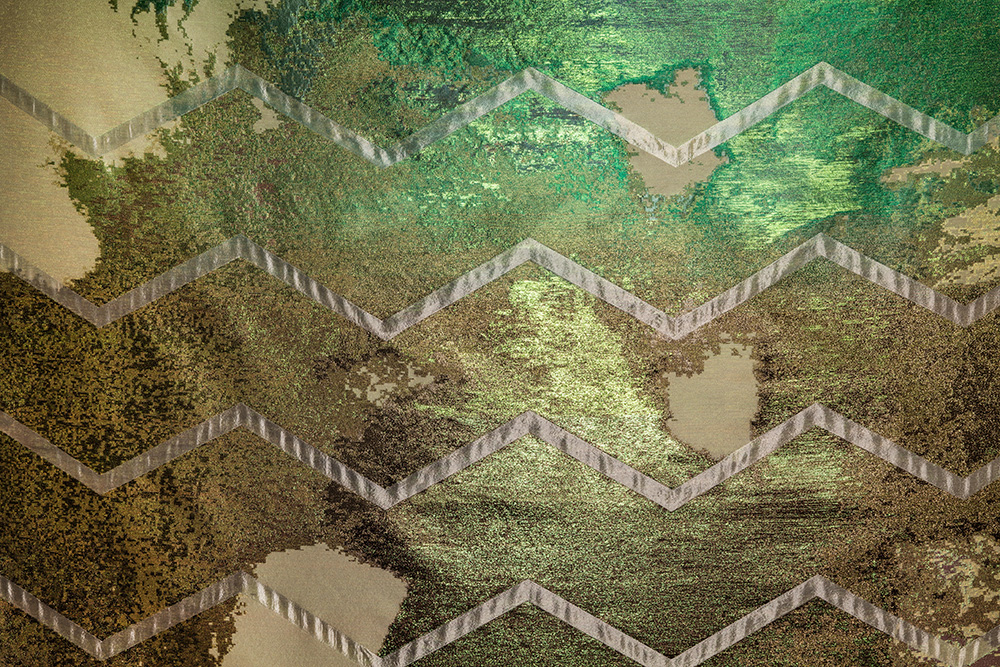 Mt. Funaoka, a scenic spot in the Northern region of Kyoto, has long been adored by locals, with its abundance of trees and very few naturalized plants. The different mountain trails are represented by the recurrent “Yamajimon” pattern and woven with a variety of green yarns for gradation. |
Art Director : AtMa inc.
[MESSAGE]
“Kyoto, the landscape of Four Symbols” is woven into existence using two distinct techniques: traditional hand weaving by Japanese artisans, and machine weaving to challenge new ideas. The woven landscape installation tells the tale of Kyoto, which is home to Kawashima Selkon Textiles. The fabric sculptures, which were made using a combination of traditional and modern techniques, come in a variety of colors and expressions, and their transitions elicit a spectrum of emotions in the viewer. In this age of excess digital information and products, the physicality of this installation and the traditional stories woven into the fabrics can only be felt, not understood. People respond to narratives. The narrative of an ever-changing landscape.
[PROFILE] https://atma-inc.com/
AtMa inc. is a creative unit established in 2013 by Ayumi Koyama and Makoto Suzuki. The studio is specialized in spacial design for fashion retail stores, restaurants, and window displays and in creative direction for hotels and apartments. Recently, their practices have also expanded to product design and installation. They attracted a great deal of attention during their participation in Milan Design Week in 2019 and also won the People’s Choice of FRAME AWARDS 2020 Emerging Designer of the year.
[AWARD]
FRAME AWARD 2021 Retail shop design, Longlisted
FRAME AWARD 2020 Emerging Designer of the year, The Peoples Choice
Dezeen AWARD 2020 Emerging Designer of the year, Longlisted
Dezeen AWARD 2020 Small retail shop, Longlisted
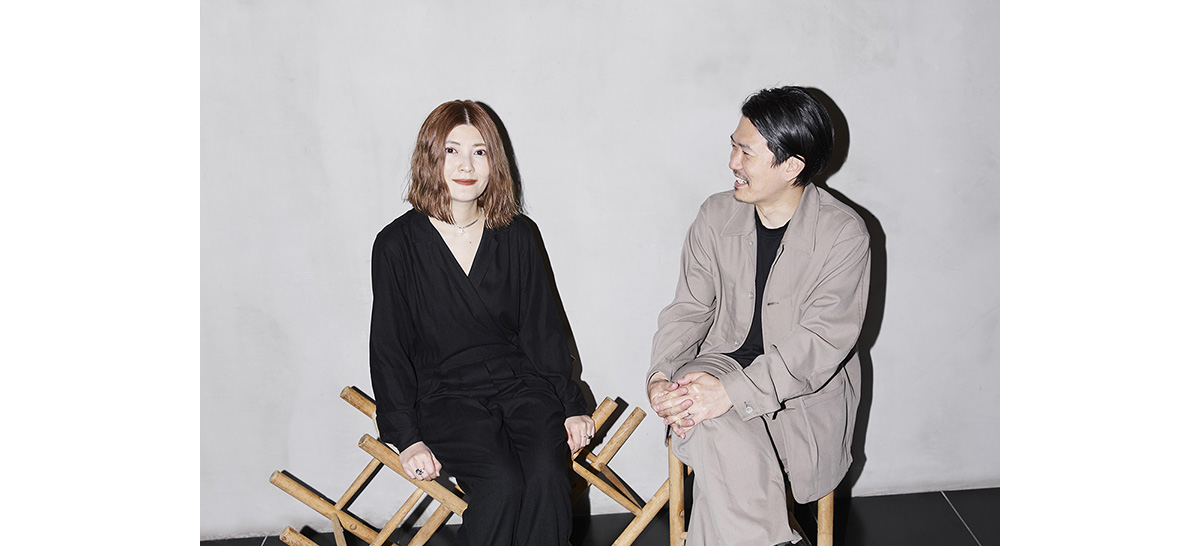
Circolo Filologico Milanese
Circolo Filologico Milanese was established in 1872 by Eugenio Torelli Viollier (founder of the Corriere della Séra, Italy’s oldest national newspaper) to promote and disseminate the study of culture with a special emphasis on foreign languages and civilizations. It is the oldest cultural association in Milan, and one of Italy’s first. It has won numerous prestigious honors, and its members include writers, poets, playwrights, politicians, academics, the mayor of Milan, and other notable figures. The building was reopened in May 1908 with a large skylight in the central hall and a front symbolic of the period’s architectural style, including a wrought-iron balcony on the first floor. The library that will host the exhibition “WOVEN NARRATIVES – Kyoto, the landscape of Four Symbols -” was constructed in the same year. Since 1875, the library’s collection has grown to over 100,000 volumes, including many rare and antiquarian books.
Event Overview
| Title | WOVEN NARRATIVES – Kyoto, the landscape of Four Symbols – |
| Exhibition Dates | June 7th (Tuesday) – June 12th (Sunday), 2022. 10:00 – 20:00 *June 8th (Wednesday), 2022. 10:00 – 18:30 |
| Press Preview | June 6th (Monday), 2022. 12:00 – 20:00 *The two designers of AtMa inc. will be at the gallery. Please contact in advance for interview requests. |
| Venue | Circolo Filologico Milanese 2F 8B Web : https://filologico.it/ Address : Via Clerici 10, 20121 Milano MAP |
| Exhibition Area | Approx. 75㎡ |
| Art Direction / Installation Design / Pattern Design | Makoto Suzui / Ayumi Koyama (AtMa inc.) |
| Graphic Design | Yusuke Sugimori (apart-apart inc.) |
| Lighting Design | Izumi Okayasu (Izumi Okayasu Lighting Design) |
| Exhibition Cooperation | KOYA JAPAN Lighting Co., Ltd. |
| Event Site | https://www.kawashimaselkon.co.jp/event/milan2022/en/ |
Kawashima Selkon Textiles
Kawashima Selkon Textiles is a fabric manufacturer with a 179-year history, having been founded in Kyoto in 1843. It has supplied textiles to the Meiji Palace in the past and more recently, to the Kyoto State Guest House as well as numerous luxury hotels. In addition to the traditional hand-weaving techniques mastered by its craftsmen, the company is integrating machine weaving techniques that harness modern technology and is committed to both cultural heritage and technological innovation. The company’s headquarters in Kyoto house a textile manufacturing plant that handles integrated production from planning and design to dyeing and weaving, the Kawashima Textile Museum, which houses works of significant historical importance, and the Kawashima Textile School, where traditional weaving techniques are taught to the next generation. All in the name of preserving, developing, and spreading textile culture of Japan.
